3 Social science theories, methods, and values
Learning Objectives for this Chapter
After reading this Chapter, you should be able to:
- understand, apply, and evaluate core social science values, concepts, and theories, which can help inform and guide our understanding of how the world works, how power is defined and exercised, and how we can critically understand and engage with these concepts when examining the world around us.
Social science theory: theories to explain the world around us
As we have discussed in previous chapters, social science research is concerned with discovering things about the social world: for instance, how people act in different situations, why people act the way they do, how their actions relate to broader social structures, and how societies function at both the micro and macro levels. However, without theory, the ‘social facts’ that we discover cannot be woven together into broader understandings about the world around us.
Theory is the ‘glue’ that holds social facts together. Theory helps us to conceptualise and explain why things are the way they are, rather than only focusing on how things are. In this sense, different theoretical perspectives, such as those discussed in this Chapter, act as different lenses through which we can see and interpret the world around us.
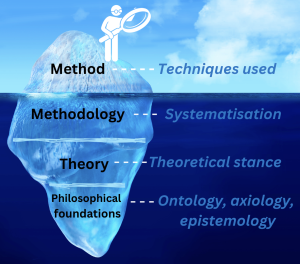
Theory testing and generation is also an important part of social scientific research. As shown in the image below, different theories are rooted in different philosophical foundations. That is, various theories arise in accordance with different ways of seeing and living in the world, as well as different understandings about how knowledge is understood and constructed. As we learned earlier in the book, these concern both ontological and epistemological considerations, but also axiological considerations; that is, questions about the nature of value, and what things in the world hold value (including in relation to one another). While theory is rooted in these philosophical foundations, however, it also gives way to different ways of doing research, both in terms of the methodology and methods employed. Overall, using different theoretical perspectives to consider social questions is a bit like putting on different pairs of glasses to see the world afresh.
Below we consider some foundational social science theories. While these are certainly not the only theoretical perspectives that exist, they are often considered to be amongst the most influential. They also provide helpful building blocks for understanding other theoretical perspectives, as well as how theory can be applied to guide and build social scientific knowledge.
Structural functionalism

Structural functionalism is a theory about social institutions, ‘social norms’ (i.e., the often unspoken rules that govern social behaviours), and social stability. We talk more about social institutions in the next Chapter of this book, but essentially they are the ‘big building blocks’ of society that act as both repositories and creators/instigators of social norms. These include things like school/education, the state (often called a meta-institution), the family, the economy, and more. In this regard, structural functionalism is considered a macro theory; that is, it considers macro (large) structures in society, and concerns how they work in an interdependent way to produce what structural functionalists believe to be ‘harmonious’ and stable societies. Structural functionalists are particularly concerned with social institutions’ manifest and latent functions, as well as their functions and dysfunctions (Merton [1910-2003]).
Manifest functions of social institutions include things that are overt and obvious. By contrast, latent functions of social institutions are those that are more hidden or secondary. For instance, a manifest function of the social institution of school is to teach students new knowledge and skills, which can assist them to move into chosen careers. Alternatively, we might also argue that school has other latent functions, such as socialisation and conformity to social norms, and building relationships with peers.
In addition to manifest and latent functions, structural functionalists are also concerned with the functions and dysfunctions of social institutions. They believe, for instance, that dysfunctions play just as much of an important role as functions, because they enable social institutions to identify and punish them, thereby making an example of dysfunctional elements (e.g., punishing those committing crime). This serves to reinforce social norms around how society should function.
Reflection exercise
Take a piece of paper and, in your own words, write down a brief definition of structural functionalism. Then re-read the above sub-section. How does your understanding fit with the information above?
Structural functionalism: want to learn more?
If you’d like to reinforce your understanding of structural functionalism, the below video provides a good summary that might be helpful.
Phenomenology
Phenomenology is the study of our experiences and how our consciousness makes sense of the phenomena (be they objects, people or ideas) around us. As a methodology or approach in the social sciences it has garnered renewed interest in the last few decades to better understand the world around us by studying how we experience the world in a subjective and often individual manner. It is, thus, considered a ‘micro’ theory.

This philosophical approach was developed by Edmund Husserl (1859–1938), and his students and critics in France and Germany (key figures were philosophers Martin Heidegger (1889-1976), Jean-Paul Sartre (1905-1980) and Maurice Merleau-Ponty (1908-1961)) and later made it to the US via influential sociologists, such as Alfred Schütz (1899–1959).
Phenomenologists reject objectivity and instead focus on the subjective and intersubjective, the relations between people, and between people and objects. So, rather than trying to come to some objective truth, they are more interested in relationships and connections between the individual and the world around them. Indeed, there is a strong centering of and focus on the individual and their experiences of the world that phenomenologists believe can tell us about society at large. The individual is also key, as there is a focus on the sensory and the body both as instruments of enquiring as well as enquiry. Thus, we are always already part of the world around us and have to make sense of being here, but also want to go beyond ourselves by understanding others and how they relate to the world. The body features as a key site for such enquiries as it is the physical connection we have with people and objects around us. Further, there is a focus on everyday, mundane experiences as they have much to tell us about how society operates. This background environment in which we as people operate is called a lifeworld, the shared horizon of experience we share and inhabit. It is marked by linguistic, cultural, and social codes and norms.
One key method inherent to Husserl’s early approaches is ‘bracketing’ , the process of standing back or aside from phenomena to understand it better. Such processes of ‘reflexivity’ and understanding our taken for granted attitudes and beliefs about certain phenomena are crucial to enable the social sciences to better understand the world around us. Debates in philosophy continue around whether such a bracketing is ever fully possible, especially considering that we as humans remain trapped in our minds and bodies. Nonetheless, phenomenology has had a profound impact in most social sciences to redirect the focus towards the intersubjective nature of life and the lifeworld, within which we experience the world around us.
Reflection exercise
Take a piece of paper and, in your own words, write down a brief definition of phenomenology. Then re-read the above sub-section. How does your understanding fit with the information above?
Phenomenology: want to learn more?
If you’d like to reinforce your understanding of phenomenology, the below video provides a good summary that might be helpful.
Symbolic interactionism
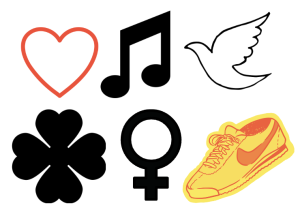
Symbolic interactionism is related to phenomenology as it is also a theory focused on the self. In this regard, it’s also a micro theory – it has particular focus on individuals and how they interact with one another. Symbolic interactionists say that symbolism is fundamental to how we see ourselves and how we see and interact with others. George Herbert Mead (1863-1931) is often regarded as the founder of this theory and his focus was on the relationship between the self and others in society. He considered our individual minds to function through interactions with others and through the shared meanings and symbols we create for the people and objects around us. Mead’s best known book Mind, Self, Society, was posthumously put together by his students and demonstrates how our individual minds allow us to use language and symbols to make sense of the world around us and how we construct a self based on how others perceive us.

Charles Cooley’s (1864-1929) concept of the “looking glass self” points out, for instance, that other peoples’ perceptions of us can also influence and change our perceptions of ourselves. Other sociologists, such as Erving Goffman (1922-1982), have built on this understanding, suggesting that ‘all of life is a stage’ and that each of us play different parts, like actors in a play. Goffman argued that we adapt our personality, behaviours, actions, and beliefs to suit the different contexts we find ourselves in. This understanding is often referred to as a ‘dramaturgical model’ of social interaction; it understands our social interactions to be performative – they are the outcomes of our ‘play acting’ different roles.
In explaining this theory, Goffman also referred to what he called ‘impression management’. As part of this, for instance, Goffman drew a crucial distinction between what he referred to as our ‘front stage selves‘ and our ‘backstage selves‘. For Goffman, our ‘front stage selves’ are those that we are willing to share with the ‘audience’ (e.g., the person or group with whom we are interacting). Alternatively, our ‘backstage selves’ are those that we keep for ourselves; this is the way we act when we are alone and have no audience.
Goffman also pointed to the important role that stigma can play in how we see ourselves and thus, how we act and behave in relation to others. Stigma occurs when “the reaction of others spoils normal identity”. Goffman argued that those who feel stigmatised by others (e.g., through public discourses and ‘frames’ of social issues that vilify certain groups of people) also experience changes in the way they see themselves – that is, their own sense of self-identity is ‘spoiled’. This can lead to other negative effects, such as social withdrawal and poorer health and wellbeing.
Reflection exercise
Take a piece of paper and, in your own words, write down a brief definition of symbolic interactionism. Then re-read the above sub-section. How does your understanding fit with the information above?
Reflection exercise
This exercise is to be conducted in small groups. First, get into a small group with other students. Then, do the following:
- Think about your daily life, activities, and interactions with others.
- Take a few moments to identify at least three examples of social symbols that you and other group members frequently use to interpret the world around you.
- Talk about how each of the group members interprets/responds to these symbols. Are there similarities? Are there differences?
Students should share/discuss their thoughts within the group, and if undertaken in a class environment, then report back to the class.
Symbolic interactionism: want to learn more?
If you’d like to reinforce your understanding of symbolic interactionism, the below videos provide good summaries that might be helpful.
Symbolic Interactionism (YouTube, 3:33) provides an easy-to-understand summary of symbolic interactionism:
What does it mean to be me? Erving Goffman and the Performed Self (YouTube, 1:58) provides a helpful summary of Erving Goffman’s conception of the ‘performed self’ – including his notions of a ‘front stage’ and ‘backstage’ self:
Conflict theories
Conflict theories focus particularly on conflict within and across societies and, thus, are particularly interested in power: where it does and doesn’t exist, who does and doesn’t hold it, and what they do or don’t do with it, for example. These theories hold that societies will always be characterised by states of conflict and competition over goods, resources, and more. These conflicts can arise along various lines, though
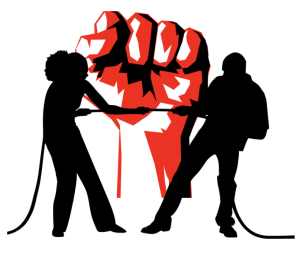
this group of theories emanate from the work of Karl Marx (1818-1883), who saw the capitalist economy as a primary site of conflict.
In Marx’s view, social ills emanated particularly from what he described as an upper- and lower-class structure, which had been perpetuated across multiple societies (e.g., in ancient societies in terms of slave owners/slaves, or in pre-Enlightenment times between the feudal peasantry/aristocracy). He saw capitalism as replicating this upper/lower class structure through the creation of a bourgeoisie (upper class, who own the means of production) and proletariat (lower class, who supply labour to the capitalist market). Marx also talked about a lumpenproletariat, an underclass without class consciousness and/or organised political power. Classical Marxism takes a macro lens: it is particularly concerned with how power is invested in the social institution of the capitalist economy. In this sense, classical Marxism represents a structural theory of power.
Marx argued that the only way for society to be fairer and more equal was if the proletariat was to rise up and revolt against the bourgeoisie; to “smash the chains of capitalism”! Thus, he strongly advocated for revolution as a means of creating a fairer, utopic society. He stated, “Philosophers have hitherto only interpreted the world, in various ways; the point is to change it” (Marx 1968: 662). Nevertheless, a series of revolutions in the early 20th century that drew on Marxist thinking resulted in power vacuums that made way for violent, totalitarian regimes, as political philosopher Hannah Arendt (1906-1975) argued in On the Origins of Totalitarianism. On this basis, subsequent conflict theorists (and critical theorists) have tended towards advocating for more incremental reforms, as opposed to revolution.
Reflection exercise
Take a few moments to watch the below two videos, which explain conflict theory in greater detail.
Key concepts: Conflict theory – definition and critiques (YouTube, 2:49):
After watching these videos, take a piece of paper and, in your own words, write down a definition of conflict theories. After doing so, re-read the above sub-section. How does your understanding fit with the information in the above sub-section, and in the videos? Was anything missing? Is anything still unclear?
Critical theories
Marx saw the capitalist economy as a primary site of oppression, between the working class and the property owning class. Marx advocated for revolution, where the proletariat were urged to rise up and break the chains of capitalism by overthrowing the bourgeoisie. Marx saw this as being necessary for ensuring the freedom of the working classes. Critical theory develops from the work of Karl Marx, supplementing his theory of capitalism with other sociological and philosophical concepts.
Gramsci and cultural hegemony
In addition to Marx, critical theory utilised the work of Italian political philosopher Antonio Gramsci, specifically his concept of ‘Cultural Hegemony’. When we refer to ‘hegemonic’ social norms, we’re referring to social norms that are regarded as ‘common sense’ and thus, which overshadow and suppress alternative norms. Hegemonic norms typically reflect the values of the ruling classes (in Marxist terms, the bourgeoisie). To learn more, you might like to watch the video below:
Hegemony: WTF? An introduction to Gramsci and cultural hegemony (YouTube, 6:25)
Developing from this, critical theory also considers how power and oppression can operate in more subtle ways across the whole of society. Critical theory does not seek to actively bring about revolution, as the possibility for a revolution in the years post-World War Two was unlikely. Whilst critical theorists are by no means opposed to revolution, their focus lies more in identifying how capitalist society and its institutions limits advancement of human civilisation. In this respect, conflict theorists see more opportunities for praxis than classical Marxists.
Critical theory observes how the Enlightenment ideals of freedom, reason, and liberalism have developed throughout the first half of the 1900s. Ultimately, critical theorists see that reason has not necessarily progressed in a positive way throughout history. In fact, reason has developed to become increasingly technical, interested in classifying, regulating, and standardising all aspects of human society and culture. German philosopher Theodor Adorno (1903-1969) thought that Nazi Germany and the holocaust is a devastating example of the potential evils of rationality if developed without a critical perspective.
Another, less extreme, example of this tendency toward standardisation is in the production of art and culture. Big budget films, typically in the superhero or science fiction genre, all appear to be virtually identical: extravagant special effects, epic soundtracks, and relatively simple plots. However, this is not to say that such films are of a poor quality. Rather the similarity and popularity of these films indicates a homogenisation of culture. If culture is merely the reproduction of the same, how can society progress beyond its current point?
This critique of the development of reason throughout the 20th century does not mean that we must abandon reason entirely. To do so would be to discount the vast wealth of knowledge that humanity has come to grasp, as well as prevent further knowledge production. Instead, critical theorists argue that reason should be critiqued to uncover what has been left out of its development thus far, as well as open up the possibility for a more free, progressive form of society.
At its core, then, critical theory can be thought about as being an additional theoretical lens through which we can look at and understand the social world around us. In tune with Flyvbjerg’s (2001) conception of phronetic social science, critical theorists are also concerned with disrupting the systems they observe as a means of achieving social change. Critical theory urges us to recognise, understand and address how capitalist society reproduces itself and limits the free organisation of human beings.
Reflection exercise
Take a few moments to watch Critical theory definition and critiques (YouTube, 3:26), which explains critical theory in greater detail.
Take a piece of paper and, in your own words, write down a brief definition of critical theories. Then re-read the above sub-section. How does your understanding fit with the information above and the video?
Reflection exercise
Critical theory can be applied in myriad different ways to better understand the world around us. In Critical theory and the production of mass culture (YouTube, 2:12), critical theory is adopted as a lens to understand and critique the production of mass culture. Watch the video and then consider the questions below.
- Can you think of examples where you could argue that the primary objective of producing art is to preserve the economic structure of the capitalist system?
- Do you agree with the proposition that mass-consumed entertainment, like popular television shows, are only produced as a source of light entertainment and escapism from work, and thus serve to placate and pacify the worker? Why or why not? (What other purposes might such entertainment serve, if any?)
- Do you agree with Adorno’s proposition that the products of the ‘culture industry’ are not only the artworks, but also the consumers themselves? Why or why not?
Critical race theory
Critical race theory applies a critical theory lens to the notion of race, seeking to understand how the concept of race itself can act as a site of power and oppression. Arising from the work of American legal scholars during the 1980s (including key thinkers like Derrick Bell [1930-2011] and Kimberlé Crenshaw [1959-]), it originally sought to understand and challenge “the ways in which race and racial power [were]… cosnstructed and represented in American legal culture and, more generally, in American society as a whole.” (Crenshaw et al. 1995: xiii) In particular, it questioned whether the civil rights afforded to African Americans in the aftermath of the civil rights movement had made a substantive impact on their experiences of social justice. Critical race theorists argued that more needed to be done; that civil rights had not had the desired impacts because (amongst other reasons) they:
- were imagined, shaped and brought into being by (predominantly) white, male middle- or upper-class lawyers, and thus, were only imagined within the bounds of white ontology,
- did not move beyond race – race still mattered, and
- implicitly perpetuated white privilege (e.g. they were constrained to only imagine redress and justice within the existing oppressive, white hegmonic system).
Crenshaw (1995: xiii) writes that, although critical race scholars’ work is heterogenous, they are nevertheless united by the following common interests:
- “The first is to understand how a regime of white supremacy and its subordination of people of color have been created and maintained in America, and, in particular, to examine the relationship between that social structure and professed ideas such as ‘the rule of law’ and ‘equal protection’.”
- “The second is a desire not merely to understand the vexed bond between law and racial power but to change it.”
In Australia, scholars have also taken up aspects of a critical race lens to understand how privilege is bound up with race. As Moreton-Robinson (2015: xiii) puts it, in Australia:
Race matters in the lives of all peoples; for some people it confers unearned privileges, and for others it is the mark of inferiority. Daily newspapers, radio, television, and social media usually portray Indigenous peoples as a deficit model of humanity. We are overrepresented as always lacking, dysfunctional, alcoholic, violent, needy, and lazy… For Indigenous people, white possession is not unmarked, unnamed or invisible; it is hypervisible…
Crenshaw has been crucial in also stressing the key importance of understanding how race can also intersect with other aspects of social identity, such as gender, to produce a ‘double’ or ‘triple’ oppression. In Australia, Professor Aileen Moreton-Robinson’s 2000 book, Talkin’ up to the white woman, was also crucial in understanding how Australian feminism could also be oppressive of Indigenous Australian women by not seeing and hearing them or the specific issues they face/d. She called for the need for “white feminists to relinquish some power, dominance and privilege in Australian feminism to give Indigenous women’s interest some priority” (Moreton-Robinson 2000: xxv). This emphasised that an intersectional lens was needed to acknowledge the different but cumulative impacts of both racial oppression and sexism. At the centre of this argument is the reality that “all white feminists [in Australia] benefit from colonisation; they are overwhelmingly represented and disproportionately predominant, have the key roles, and constitute the norm, the ordinary and the standard of womanhood in Australia” (Moreton-Robinson 2000: xxv).
Uproar over critical race theory
During 2020, racial sensitivity training in the USA prompted widespread discussion about critical race theory. Former US President, Donald Trump, posits in the video below that the theory, and the kinds of racial sensitivity training it promotes, are fundamentally racist – against white people. Others argued that this represented a deep misunderstanding of the theory, but also an ignorance of the extent and power of white privilege.
For an example of former President Trump’s views, watch Trump: Racial sensitivity training on white privilege is ‘racist’ (YouTube, 3:16):
Postmodern critique of critical race theory
Postmodernists have levelled critique at critical race theory on the basis that understanding/explaining power as being rooted in racial difference has the consequence of reinforcing and perpetuating the validity of ‘race’. Postmodernism, however, rejects the distinct, conceptual bounds of ‘race’ and racialised identities. Instead, it sees race itself as a social construction, which should be questioned and disrupted, thereby leading to new insights that aren’t constrained by socially constructed definitions of race.
Kwame Anthony Appiah, for example, seeks to “probe the very definitions of race itself. He bypasses the empirical question of whether racism exists to ask the theoretical question of what race and racism are” (in Chong-Soon Lee 1995: 441)
Reflection exercise
Take a piece of paper and, in your own words, write down a brief definition of critical race theory. Then re-read the above sub-section. How does your understanding fit with the information above?
Putting theory into action: rethinking crime through a critical lens
Critical criminologists apply a critical theory lens to the study of crime and criminality. In this regard, critical criminology is concerned with understanding how the criminal justice system can act as a site of power and oppression; a perspective that tends to sit in contrast with western (non-critical) criminology, which sees the criminal justice system as a natural social institution that has the primarily purpose of protecting society against deviants (criminals) and making an example of those who fail to comply with hegemonic social norms. (This non-critical view draws parallels, for example, with the perceived ‘functions’ of the criminal justice system under a structural functionalist perspective, and its role in making examples of ‘dysfunctional’ elements of society.)
Critical criminologists in Australia have considered the role of the criminal justice system as a key site of oppression under, for example, Australian settler colonialism. For instance, Indigenous Australians are, per capita, the most incarcerated peoples in the entire world (Anthony & Baldry 2017) and these incarceration rates are rising, not reducing (ABS 2018). In using a critical lens to understand the difference between incarceration rates for Indigenous and non-Indigenous Australians, however, we can seek better insight into how the criminal justice system operates as a site of oppression, perpetuating white settler colonial norms and values, which seek to punish alternative ontologies and epistemologies. Lynch (cited in Cunneen and Tauri 2016: 26) argued,
In short, criminology is one of the disciplines that established the conditions necessary for maintenance of the status quo of power. It can only do so by oppressing those who would undermine the status quo. In this sense, criminology must be viewed as a science of oppression.
In part, this oppression operates through the construction of knowledge and truth within (positivist) criminology (which relates to Foucault’s conception of power-knowledge, as we touched on last week). In turn, this also involves what Cunneen and Tauri (2016: 26) describe as “the ideologically driven dismissal of Indigenous knowledge about the social world as ‘subjective’, ‘unscientific’, and/or at best ‘folk epistemology’… which in turn paves the way for excluding other ways of knowing from the Western, criminological lexicon”.
In their book, Decolonising criminology, Blagg and Anthony (2019: 22-23) set out a taxonomy for what they see as a decolonised criminology (noting, though, that Blagg and Anthony themselves are non-Indigenous researchers, though they have worked closely with Indigenous peoples and communities for decades). In their taxonomy (which we have included an adapted version of below), they include the following probing comparisons between a positivist (largely uncritical) criminology and a decolonised (critical) criminology:
| Positivist criminology | Decolonised criminology (postcolonial, post-disciplinary) | |
|---|---|---|
| Underlying assumptions | The state’s criminal laws and its role in Indigenous peoples’ lives is considered to be neutral. Criminological knowledge is considered to be objective and free of bias. | Criminal laws are understood as a harmful technology of control and subordination, used by the colonial settler state against Indigenous peoples. Criminological knowledge is considered to be subjective, reflecting status quo power relations. Thus, there is an acknowledged need for a “plurality of critical and Indigenous epistemologies”. |
| Typical research questions | What leads Indigenous peoples to commit offences? How can the state respond to and reduce rates of Indigenous offending? How can the state manage the ‘risk’ that Indigenous peoples pose to social order? | What leads the state to offend against and harm Indigenous peoples? What is needed for the state, and other key institutions, to stop harming Indigenous peoples? How might the state, as well as other actors, repair the harms done to Indigenous peoples? How can Indigenous peoples’ self-determination be supported? |
| Typical research focus | Indigenous peoples’ deficits (e.g., offending) and the state’s ability to counter and address these deficits via the criminal justice system. | The state’s deficits (e.g., violence and offending against Indigenous peoples) and Indigenous peoples’ resilience and strength in the face of such offending, as well as their ability to self-determine holistic strategies to support and enhance their own emotional, cultural, and social wellbeing. |
| ‘Experts’ | Researchers (including criminologists) in institutions like universities | Indigenous peoples who have first-hand experience of the effects of the state’s criminal justice system, and who are experts at nurturing their own wellbeing and self-determination. |
| Typical research outputs | Academic journal articles, books, and chapters; official reports. | Information that is suited to the needs and priorities of Indigenous communities; informative outputs that support Indigenous activism, advocacy, and self-determination. |
| Outcomes and impacts | Enhancing institutional knowledge and contributing to policy reforms that further strengthen the state’s responses to crime (particularly via the criminal justice system). | Enhancing the capacity of Indigenous knowledge production and contributing to reforms that attend to the needs and priorities of Indigenous peoples. This includes by supporting Indigenous self-determination, and efforts at decarceration. |
A table comparing positivist and decolonial approaches to criminology.
Source: Authors’ adaptation from Blagg & Anthony (2019: 22-23)
The probes and questions that Blagg & Anthony pose in the above taxonomy are critical in their focus and intent; they seek to critique the criminal justice system as a site of colonial power, but they also seek to change it — through research that produces knowledge about these truths. This is, in essence, a reframing (to use Bacchi’s term) of the nature of criminological research towards a richer, and more historically and culturally contextualised understanding of the Australian criminal justice system. As a result, this produces different knowledge about crime and justice in Australia: knowledge that shifts blame away from the individual (the ‘bad’ Indigenous citizen, to use Moreton-Robinson’s [2009] language) to the structures, history and continuation of colonial oppression.
Critical or radical criminology?
Radical criminology is rooted in the Marxist conflict tradition and sees the capitalist economy as being central to the definitions of crime (arrived at by the bourgeoisie) that constrict, control and suppress the working classes (proletariat).
In contrast (or in addition to), critical criminology is interested in more than just class relations and also sees different opportunities for praxis – tending to favour a more incremental approach to social change as opposed to widespread revolution (Bernard 1981)
Reflection exercise
Drawing on a critical criminology and decolonising perspective, consider the below graph, which shows the over-representation of Indigenous Australians in prisons, indicating an upward trend from 2008-2018. Then consider, from a critical criminology standpoint, what kinds of ‘truths’ might you draw on to help explain this trend?
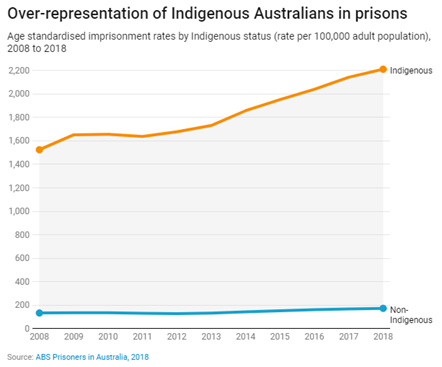
(To guide your thinking, you may like to revisit the above taxonomy by Blagg and Anthony.)
Reflection exercise
Watch the below short clip of Senator Patrick Dodson talking in March 2021 about the issue of Aboriginal and Torres Strait Islander deaths in custody. Consider LNP Senator, Amanda Stoker’s response to Senator Pat Dodson, in particular her comment that she “understand[s] the outrage is real… because the lives of every person, though our justice system are important, no matter the colour of their skin.”
In #Estimates, @SenatorDodson fires up over a lack of action on deaths in custody. @stoker_aj‘s response: “I understand the outrage is real…because the lives of every person, through our justice system are important, no matter the colour of their skin.” #Auspol @SBSNews @NITV pic.twitter.com/jgsb8y9YcD
— Naveen Razik (@naveenjrazik) March 26, 2021
What do you think about Senator Stoker’s response to Senator Dodson? How might you analyse her response, through a critical race theory lens?
Reflection exercise
Choose one of the following social issues:
- The gender pay gap
- Poverty
- The workplace ‘stress’ epidemic
- Homelessness
- Childhood obesity
Consider how your chosen social issue might be explained by drawing on the different theoretical perspectives outlined earlier in this Chapter. Record your thoughts in a short, written explanation.
Reflection exercise: a critical reading of meritocracy
Kim and Choi (2017: 112) define meritocracy as “a social system in which advancement in society is based on an individual’s capabilities and merits rather than on the basis of family, wealth, or social background.” According to Kim and Choi (2017: 116), meritocracy has two key features: “impartial competition” and “equality of opportunity”.
The notion of meritocracy has arisen over the past few centuries primarily in response to feudalism and absolute monarchy, where power and privilege are handed down on the basis of familial lines (‘nepotism’) or friendships (‘cronyism’). This kind of system could (and often did) place people into positions of power, regardless of whether they were the most appropriate or ‘best’ person for the job. In essence, then, the notion of meritocracy is intended to tie social advancement to merit; that is, the focus is supposed to be on ‘what you know’ rather than ‘who you know’, which seems a noble cause, right? Many have argued, however, that a blinkered belief in meritocracy leaves a lot of things out of the ‘frame’.
The belief in meritocracy, and its focus on ‘what you know’ rather than ‘who you know’, can have both positive and negative impacts. Take a piece of paper and write a short list of each.
If critical theory operates according to the broad Marxist understanding of history as class struggle, post-structuralism is a theory that attempts to abandon the idea of grand historical narratives altogether. Fundamentally, post-structuralism differs from other social theories in its rejection of metanarratives, its critique of binaries, and its refusal to understand all human action as being shaped solely by universal social structures. Whilst there is much disagreement between post-structuralist thinkers, these three broad trends help us to understand this social theory.
Post-structuralism
Post-structural accounts of conflict and power can take a macro and micro lens. They see power as transcending social structures, like social institutions (e.g., the state, the economy) and instead being all around us at all times. Michel Foucault (1926-1984), for example, argued that power is everywhere and acts upon us to shape our identities, bodies, behaviours, and being. In terms of a liberal democratic society, therefore, where coercive (‘sovereign’) power is only exerted by the state under certain specific circumstances, Foucault argued that the state otherwise uses its power to create ‘responsibilised’ citizens who absorb hegemonic (i.e. authoritative/dominant) social norms and use these to govern themselves. This relates to what Fairclough (1995: 257) referred to as power by consent:
We live in an age in which power is predominantly exercised through the generation of consent rather than through coercion… through the inculcation of self-disciplining practices rather than through the breaking of skulls (though there is still unfortunately no shortage of the latter).
Foucault was also particularly interested in the link between power and knowledge. He argued that those who hold the power tend to construct knowledge and ‘truth’ in certain ways, which can reinforce their power by, for example, perpetuating certain social norms. This is elaborated on by Watts and Hodgson (2019) in reading 5.2, where they describe Foucault’s conception of power/knowledge as follows:
Truth is not neutral or objective, and is not simply a thing that can be verified scientifically because its ‘truth value’ is dependent on the operation and circulation of power (think, for example, the oft-quoted phrase that ‘truth is whatever the powerful say it is’). In the context of the human and social sciences, power creates knowledge and is also a force for the translation of knowledge of and about human beings into practice… For example, the moment we speak into existence the concept of something as commonplace as ‘human being’ or ‘human rights’ or ‘social justice’ we are using some form of power (truth) to render such things thinkable and knowable as things in the world (Watts and Hodgson 2019: 85-86).
Reflection exercise
Take a piece of paper and, in your own words, write down a brief definition of Foucault’s post-structural concept of power. Then, re-read the above account. Does your definition align with the information above?
Beck and Risk Society
The notion of risk society is outlined by Ulrich Beck in his 1992 book ‘Risk Society: Towards a New Modernity’. Where society was once organised around wealth distribution based on scarcity, Beck argues that society is becoming increasingly based on the distribution of risks. Risks are defined as “a systematic way of dealing with hazards and insecurities induced and introduced by modernization itself” (Beck 1992: 21). Beck argues that the process of modernisation is no longer focused exclusively on the creation of new technologies, but rather the focus lies in the management of risks of potential technologies. As such, modernisation is becoming increasingly reflexive, involved not only in the production of technologies to meet needs, but rather investigating the often unknown side-effects of technologies. For example, a nuclear energy plant might be built in order to meet society’s increasing energy demand. However, this solution to a specific problem then must deal with the new issue of disposing of this radioactive waste that modernisation itself has produced. This is just one example of the ecological risks inherent with the development of new technologies, which often have unintended side-effects, that must themselves be uncovered and solved.
Postmodernism
Before we can get to postmodernism, we need to define modernism to see what postmodernism wants to supersede. Modernism describes the social upheaval and major changes of 20th century life. It is marked by processes of industrialisation, rationalisation and bureaucratisation – in short a world in which the sciences seemed to provide ever more answers and ultimate truths about the world and us. Modernism or modernity was also about hope for a new society, unfettered technological and material progress and, with advances in scientific fields, led to longer lives and new and exciting materials to make new things to make life easier (think household machines). It was also punctured by some key social movements that brought the world to the brink of destruction in the epic fight over what ultimate truth should prevail. The key political ideologies of fascism, socialism and liberalism clashed in the second World War over their different visions for a new world order. In the post war climate of a new stand-off between socialism/communism and liberalism or the Soviet bloc and ‘the West’ many writers, academics and artists became disillusioned with the modernist project. Slowly critiques of these universalising truths and meta-narratives came to think of this time as a time of postmodernism. Jean-François Lyotard (1924-1998) defined postmodernism as the ‘incredulity towards meta-narratives’, by which he meant that increasingly people were no longer persuaded by grand or master narratives about themselves, a particular nation, people or even humanity. The singular, stable, coherent modern subject was thrown into a void and thus becomes fragmented, fluid and plural in the postmodern. No one truth exists anymore and the certainty of facts becomes disputed and muddied once more. Thus, postmodernity is about scepticism, deconstruction and questioning rather than offering answers and solutions. This has made it a controversial theory or topic as it offers little in the way of hope for a better world, indeed it is often seen as dystopic. Inherent in many postmodern critiques of current society is a critique of (late) capitalism and consumer or mass culture that pervade every aspect of our lives, whilst others focus on technology and its pervasive intrusion into our daily lives.
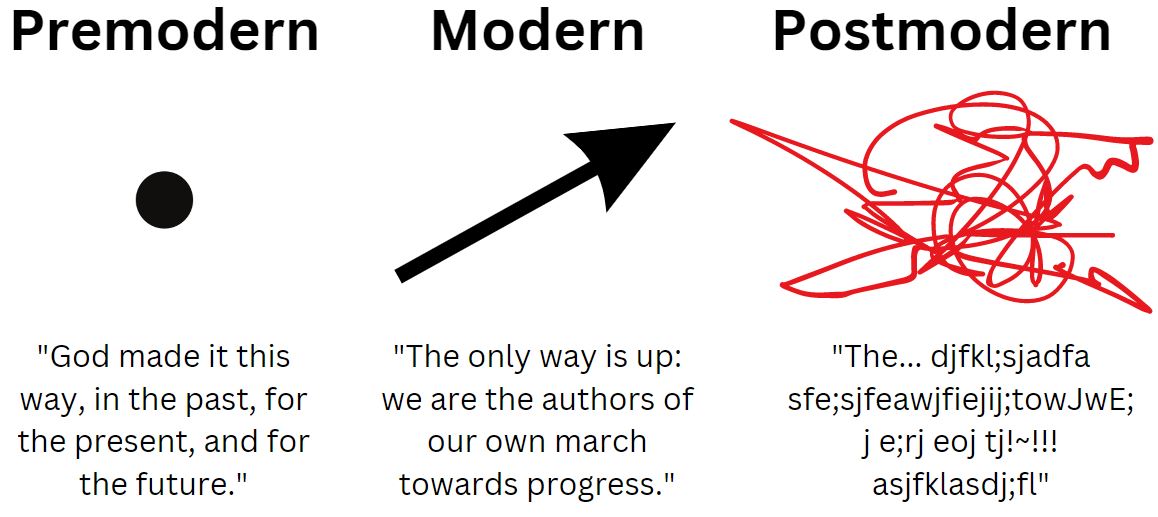
Resources for further learning
Readings:
- Moreton-Robinson, A. 2015. ‘Introduction: white possession and Indigenous sovereignty matters.’ In. Moreton-Robinson, A. The White Possessive: property, power and Indigenous sovereignty, pp. xi-xxiv.
- Powers, C. 2009. Sociology as a coherent discipline: unifying themes. In. Powers, C. Making sense of social theory, Chapter 16.
- Watts, L. and Hodgson, D. 2019. ‘Power and knowledge’. In. Watts, L. and Hodgson, D. Social justice theory and practice for social work, Chapter 5.
- Cunneen, C. and Tauri, J. 2016. ‘Towards a critical Indigenous criminology.’ In. Cunneen, C. and Tauri, J. Indigenous criminology, pp. 23-43.
- Kim, C.H. and Choi, Y.B. 2017. How meritocracy is defined today – contemporary aspects of meritocracy. Economics and Sociology, 10(1): 112-121.
- Flyvbjerg, B. 2001. ‘Values in social and political inquiry.’ In. Flyvbjerg, B. Making social science matter, Chapter 5.
Other resources:
- Watego, C. 2021. ‘Who are the real criminals? Making the case for abolishing criminology.’ (YouTube, 1:35:01),
- Anderson, E. 2017. ‘How good social science can and ought to be value-laden’ (YouTube, 17:00).
- Zigon, J. and Throop, J. 2021. ‘Phenomenology‘ Open Encyclopedia of Anthropology.

